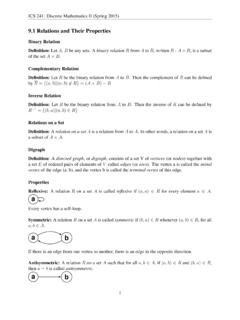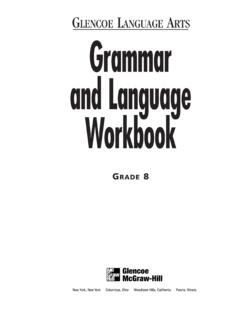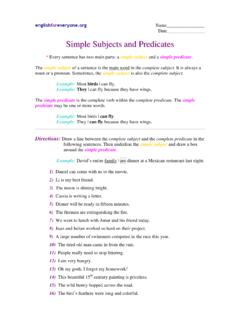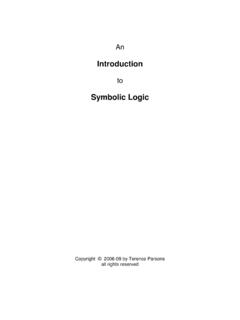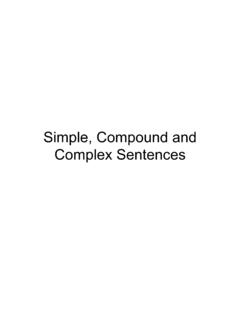Transcription of 1.4 Predicates and Quantifiers
1 ICS 141: Discrete Mathematics I (Fall 2014). Predicates and Quantifiers Predicate Logic Predicate logic have the following features to express propositions: Variables: x, y, z, etc. (the subject of a sentence), can be substituted with an element from a domain. Predicates : P, M , etc. (the predicate of a sentence). Domain: the collection of values that a variable can take. Propositions must be definitive (not vague or undefined). So, a Propositional Function is not a Proposition until all variables are defined (or bound ). Example: Let Q(x, y) denote the statement x + y > 2x . Q(x, y) has two unbound variables (x and y), and is not a proposition. Q(1, y) = 1 + y > 2 [Not a proposition] one bound variable (x = 1) and one unbound variable (y). Q(1, 2) = 1 + 2 > 2 [Proposition] two bound variables (x = 1 and y = 2).
2 Quantifiers Quantifiers provide a notation that allows us to quantify (count) how many objects in the universe of discourse satisfy the given predicate. Universal Quantifier - For all elements Existential Quantifier - There exists an element De Morgan's Law for Quantifiers xP (x) x P (x). xP (x) x P (x). pg. 53 # 5. Let P (x) be the statement x spends more than five hours every weekday in class, where the domain for x consists of all students. Express each of these quantifications in English. a) xP (x). There exists a student who spends more than five hours every weekday in class. 1. ICS 141: Discrete Mathematics I (Fall 2014). b) xP (x). Every student spends more than five hours every weekday in class. c) x P (x). There exists a student who does not spend more than five hours every weekday in class.
3 D) x P (x). No student spends more than five hours every weekday in class. pg. 53 # 11. Let P (x) be the statement x = x2 . If the domain consists of all the integers, what are these truth values? a) P (0). True c P (2). False e xP (x). True f xP (x). False pg. 54 # 25. Translate each of these statements into logical expressions using Predicates , quantifiers, and logical connectives. The domain of x is all people. c All your friends are perfect. Let F (x) be x is your friend and P (x) be x is perfect.. x(F (x) P (x)). d At least one of your friends is perfect. Let F (x) be x is your friend and P (x) be x is perfect.. x(F (x) P (x)). 2. ICS 141: Discrete Mathematics I (Fall 2014). pg. 55 # 33. Express each of these statements using quantifiers. Then form the negation of the statement, so that no negation is to the left of a quantifier.
4 Next, express the negation in simple English. (Do not simply use the phrase It is not the case that. ). b No rabbit knows calculus. C(x) = x knows calculus . Domain for x is all rabbits. x C(x). xC(x). There exists a rabbit that knows calculus. c Every bird can fly. F (x) = x can fly . Domain for x is all birds. xF (x). x F (x). There exists a bird who cannot fly. pg. 55 # 35. Find a counterexample, if possible, to these universally quantified statements, where the domain for all variables consists of all integers. a x(x2 x). No counter example. See Example 13 in section b x(x > 0 x < 0). 0. Since 0 is not less than or greater than 0, 0 is a counter example. c x(x = 1). 2. Since 2 is not 1, 2 is a counter example. pg. 56 # 59. Let P (x), Q(x), and R(x) be the statements x is a professor, x is ignorant, and x is vain.
5 Respectively. Express each of these statements using quantifiers; logical connectives; and P (x), Q(x), and R(x), where the domain consists of all people. a No professors are ignorant. x(P (x) Q(x)). b All ignorant people are vain. x(Q(x) R(x)). 3. ICS 141: Discrete Mathematics I (Fall 2014). c No professors are vain. x(P (x) R(x)). d Does (c) follow from (a) and (b)? No because we can have vain professors. 4.
